The AMD Ryzen 7 5700G, Ryzen 5 5600G, and Ryzen 3 5300G Review
by Dr. Ian Cutress on August 4, 2021 1:45 PM ESTMicrobenchmarks
Core-to-Core Latency
As the core count of modern CPUs is growing, we are reaching a time when the time to access each core from a different core is no longer a constant. Even before the advent of heterogeneous SoC designs, processors built on large rings or meshes can have different latencies to access the nearest core compared to the furthest core. This rings true, especially in multi-socket server environments.
But modern CPUs, even desktop and consumer CPUs, can have variable access latency to get to another core. For example, in the first-generation Threadripper CPUs, we had four chips on the package, each with 8 threads, and each with a different core-to-core latency depending on if it was on-die or off-die. This gets more complex with products like Lakefield, which has two different communication buses depending on which core is talking to which.
If you are a regular reader of AnandTech’s CPU reviews, you will recognize our Core-to-Core latency test. It’s a great way to show exactly how groups of cores are laid out on the silicon. This is a custom in-house test built by Andrei, and we know there are competing tests out there, but we feel ours is the most accurate to how quick an access between two cores can happen.
The Ryzen 7 5700G has the quickest thread-to-thread latency, however does offer a single slowest core-to-core latency. But compared to the 4000G series, having a single unified L3 cache reduces to core-to-core latency a good amount. The Ryzen 5 5300G has the slowest intracore latency, but the fastest average core-to-core.
Per-Core Power
One other angle to examine is how much power each core is drawing with respect to the rest of the chip. In this test, we run POV-Ray with a specific thread mask for a minute, and take a power reading 30 seconds into the test. We output the core power values from all cores, and compare them to the reported total package power.
The peak per-core power is shown as 15.2 W when one core is loaded on the Ryzen 7 5700G, and that comes down to ~8.8W when all cores are loaded. Interestingly this processor uses more power when six cores are loaded.
The Ryzen 5 5300G starts at 11.5 W for a single core, but then moves up to 12.3 W when three cores are loaded. It comes back down to 11.5 W when all four cores are loaded, but this ensures a consistent frequency (the 5300G has a 4.2 GHz Base and 4.4 GHz Turbo, explaining the small variation in loading).
Frequency Ramping
Both AMD and Intel over the past few years have introduced features to their processors that speed up the time from when a CPU moves from idle into a high-powered state. The effect of this means that users can get peak performance quicker, but the biggest knock-on effect for this is with battery life in mobile devices, especially if a system can turbo up quick and turbo down quick, ensuring that it stays in the lowest and most efficient power state for as long as possible.
Intel’s technology is called SpeedShift, although SpeedShift was not enabled until Skylake.
One of the issues though with this technology is that sometimes the adjustments in frequency can be so fast, the software cannot detect them. If the frequency is changing on the order of microseconds, but your software is only probing frequency in milliseconds (or seconds), then quick changes will be missed. Not only that, as an observer probing the frequency, you could be affecting the actual turbo performance. When the CPU is changing frequency, it essentially has to pause all compute while it aligns the frequency rate of the whole core.
We wrote an extensive review analysis piece on this, called ‘Reaching for Turbo: Aligning Perception with AMD’s Frequency Metrics’, due to an issue where users were not observing the peak turbo speeds for AMD’s processors.
We got around the issue by making the frequency probing the workload causing the turbo. The software is able to detect frequency adjustments on a microsecond scale, so we can see how well a system can get to those boost frequencies. Our Frequency Ramp tool has already been in use in a number of reviews.
In our test, the Ryzen 5 5600G jumps from 2700 to the turbo frequency in around a millisecond.


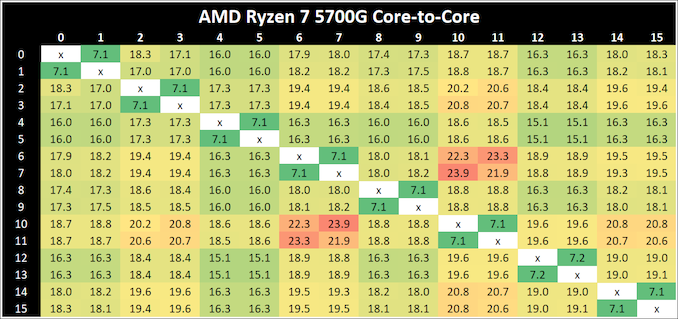
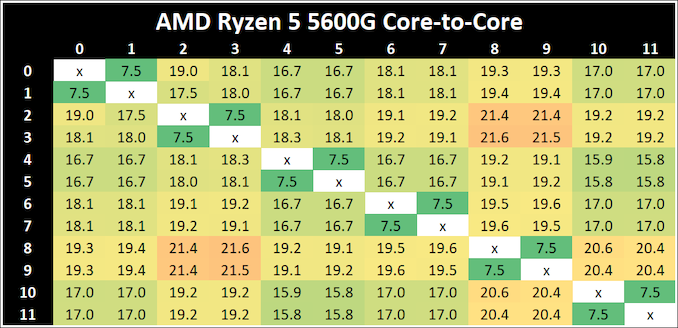
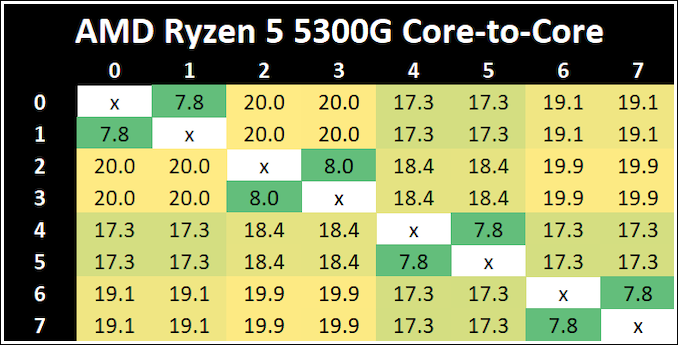
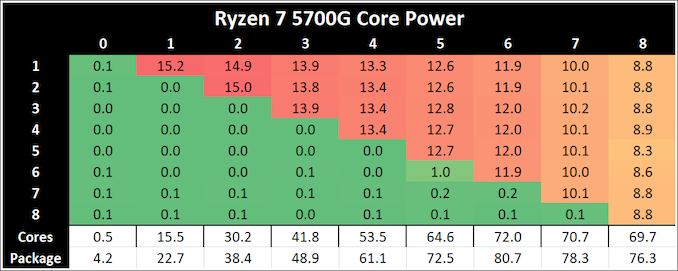

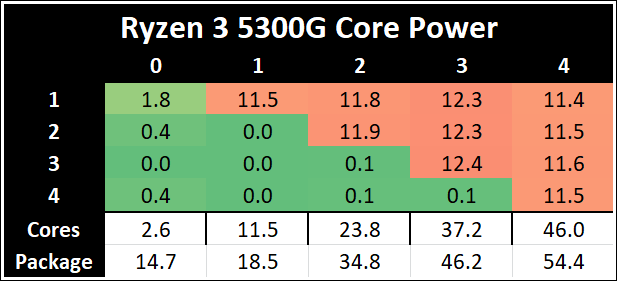
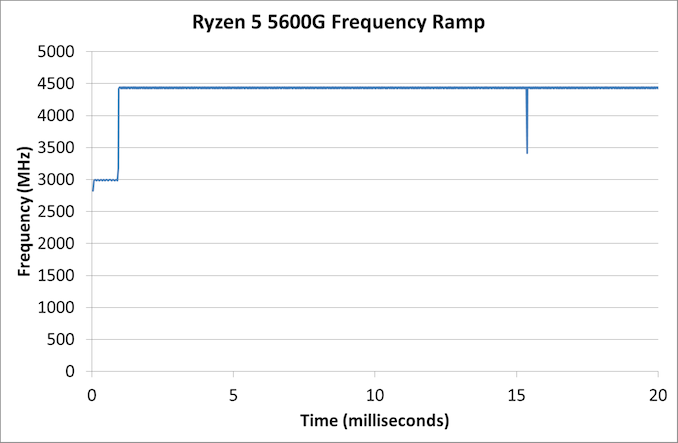








135 Comments
View All Comments
mode_13h - Tuesday, August 10, 2021 - link
> that hot, expensive Gen 4 M.2 NVMe SSD you want to use on your new> motherboard will not achieve the speed you paid dearly for.
None of the 1st gen PCIe 4.0 M.2 NVMe SSDs did, in fact. A lot of them still don't. And if you're not running it at PCIe 4.0, then it's probably also running a bit cooler.
alfatekpt - Monday, August 9, 2021 - link
Currently 5600G and 5600X are at the same price in my country. Should I get the 5600G? I already have a GPU so having an integrated one is only useful in case the GPU breaks or needs to go under warranty and I still can use the PC...mode_13h - Tuesday, August 10, 2021 - link
I wouldn't get the G. The X is faster in every single benchmark, and sometimes substantially! Plus, you get PCIe 4.0, in case that's ever of interest.If you just want a backup GPU, so you're not completely dead in the water, then maybe pick up a used low-end model (especially when GPU prices cool off, a bit). I'm seeing used RX 550's for < $100, which is roughly performance-equivalent.
If you don't care about performance, then you can go even older. I have a HD 5450 as a sort of last-resort fallback, and those are CHEAP! That's pre-GCN, but I know it still works on Linux. I think it shouldn't be too hard to find something a bit newer that's also cheap, though. Or, if you have some friends who would loan you an obsolete GPU in a pinch, that's also an option worth considering.
phoenix_rizzen - Monday, August 9, 2021 - link
The "Ryzen 5 APUs (65W)" table on page 1 lists the Ryzen 5 CPUs with 8 cores / 16 threads. Should be 6/12 instead.plonk420 - Tuesday, August 10, 2021 - link
thanks for the core to core latency tests! looks like RPCS3 will definitely benefit from it \o/Oxford Guy - Wednesday, August 11, 2021 - link
‘In our largest sub-test, the Intel processors crack on ahead,’Did I miss the stuff about performance-per-watt?
If an Intel chip needs a boatload more power to do the barely faster work, how is that a victory for Intel’s chip?
Performance-per-watt is important when we’re dealing with today’s 14nm vs. ‘7nm’ situation.
There should be an entire page devoted to performance-per-watt.
mode_13h - Thursday, August 12, 2021 - link
There is indeed a page on power consumption, but the most revealing charts only compared the three AMD 5000G-series processors to each other. That was a painful omission.Intel got included in the peak power chart, but we all know that peak power is hardly the whole story.
Oxford Guy - Thursday, August 12, 2021 - link
‘There is indeed a page on power consumption’Indeed, there is no page on performance-per-watt — and the article continues this site’s erroneous tradition of claiming that getting a slightly higher score in a benchmark whilst using a ton more power constitutes a victory.
Context is key. These articles should pay more mind to practical context, rather than things like pumping 1.45 volts into Rocket Lake and ignoring power consumption failure (vis-a-vis the competition) when examining a benchmark.
mode_13h - Friday, August 13, 2021 - link
FWIW, I was trying to agree with you. Their "Power Consumption" page had several key omissions.Oxford Guy - Sunday, August 15, 2021 - link
Regardless... peak power isn’t enough to constitute a page on performance per watt.